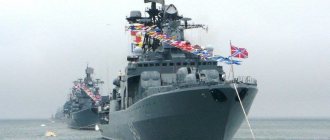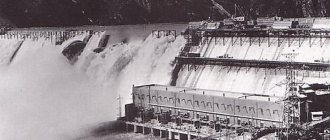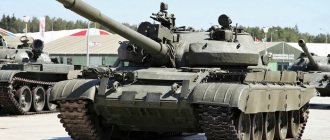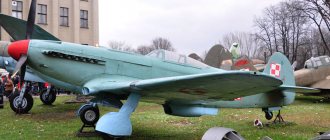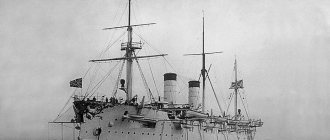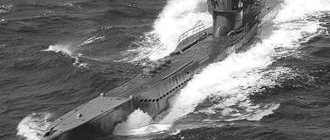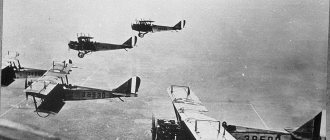Author: IdIuaM
15 November 2022 23:07
Tags: ships cruisers fleet
2685
23
In the second half of the twentieth century, 180 independent states appeared on the world map, but out of this wild diversity of countries and peoples, only two superpowers had a powerful ocean fleet - the Soviet Union and the United States. For example, no one except us and the Americans built missile cruisers en masse.
0
See all photos in the gallery
Four more European countries, in order to maintain their former status as “maritime powers,” made efforts to create their own missile cruisers, but all their attempts ended in the construction of a single ship with predominantly American weapons and systems. “Ships of prestige”, nothing more. The Americans were pioneers in the field of creating missile cruisers; by the end of the 40s, their military industry had created the first combat-ready air defense systems suitable for installation on a ship. Subsequently, the fate of the US Navy's missile cruisers was determined exclusively by escort functions as part of aircraft carrier groups; American cruisers were never designed for a serious naval battle with surface ships. But missile cruisers were especially respected in our country: during the existence of the USSR, dozens of different designs appeared in the vastness of the World Ocean: heavy and light, surface and underwater, with a conventional or nuclear power plant, there were even anti-submarine cruisers and aircraft carrier cruisers! It is no coincidence that missile cruisers became the main striking force of the USSR Navy. In a general sense, the concept of “Soviet missile cruiser” meant a large multi-purpose surface ship with a powerful anti-ship missile system. The story of the seven best missile cruisers is just a brief excursion into maritime history associated with the development of this unique class of warships. The author does not consider himself entitled to give any specific ratings or create a rating of “the best of the best.” No, this will just be a story about the most outstanding designs of the Cold War era, indicating their known advantages, disadvantages and interesting facts associated with these death machines. However, the nature of the presentation of the material will help the reader independently determine which of this “magnificent seven” is still worthy of the highest pedestal.
Albany-class guided missile cruisers
1944/1962 Total displacement 17,500 tons. Crew 1200 people. Full speed – 32 knots. Cruising range - 9000 miles (at 15 knots). Armament: - Talos long-range air defense system (2 launchers, ammunition 104 missiles); — Tartar short-range air defense system (2 launchers, ammunition 84 anti-aircraft missiles); — anti-submarine missile system ASROC (ammunition 24 missile torpedoes); - 8 Polaris intercontinental ballistic missiles (never installed); — two universal guns of 127 mm caliber.
×
0
Three American monsters, rebuilt from heavy cruisers of World War II. After the first successful experiments with missile weapons, the US Navy decided on a global modernization of the Baltimore-class artillery cruisers - they removed all weapons from the ships, cut off the superstructure and tore apart their insides. And so, 4 years later, an incredible “thug” with a tall superstructure and mast pipes studded with secret electronic equipment entered the sea. The fact that this ship was once a heavy artillery cruiser of the Baltimore class was only reminiscent of the shape of the bow. Despite its ugly appearance, the “Albany series” of cruisers were cool warships capable of providing high-quality air defense of aircraft carrier formations in the near zone (by the standards of those years) - the firing range of the Talos air defense system was more than 100 km, and two hundred missiles on board allowed fend off enemy aircraft for a long time. Advantages: - 15-centimeter armor belt, inherited from the heavy cruiser "Baltimore", - 8 fire control radars, - high installation height of radars, Disadvantages: - lack of strike weapons, - superstructures made of aluminum alloys, - archaic, in general, design.
0
0
Baltimore-class heavy artillery cruiser - this is what the Albany cruisers looked like before modernization
0
Predatory bird
By the 70s, nuclear submarines learned to use ballistic missiles and became strategic weapons.
To combat them, the Soviet Union built anti-submarine ships of ever larger size and power. Finally, the Navy headquarters decided to combine the anti-submarine capabilities of the BOD and the striking power of the missile cruiser. To project this power to any point on the globe, the new ship was equipped with a nuclear power plant. The Soviet naval commanders were greatly impressed by the “nuclear circumnavigation” of three American ships: the aircraft carrier Enterprise, the cruiser Long Beach and the frigate Bainbridge, which circumnavigated the planet in 65 days. They called the project “Orlan”. This is one of the most predatory birds in the world, and is also depicted on the US coat of arms. The chief designer was Boris Kupensky, the author of the most advanced Soviet BODs. A serious problem immediately arose: the power of nuclear power plants for submarines and icebreakers was not enough for a giant warship, and the installation of two reactors was not allowed by the military displacement limit of 8,000 tons. It was filmed by Navy Commander-in-Chief Sergei Gorshkov.
“Sergei Georgievich walked around among the models we brought, tried something on with his fingers and said: “I want this ship.” And he pointed to a two-reactor one,” said Georgy Kudrov, leading designer of the Northern Design Bureau for nuclear power plants.
The design bureau at that moment was simultaneously designing seven different ships, the workload on the designers was monstrous. 100 shipbuilding engineers from other design bureaus were sent to help. They were placed in the assembly hall: concerts and meetings were cancelled, the chairs were taken out, and drawing boards were installed in their place.
Belknap-class guided missile cruisers
1964 Total displacement 8,000 tons. Crew 380 people. Full speed – 32 knots. Cruising range - 7000 miles (at 20 knots). Armament: - universal launcher Mk.10 (80 anti-aircraft and anti-submarine missiles); — automated artillery mount Mk.42 127 mm caliber; — 3 unmanned anti-submarine helicopters DASH (later replaced by the conventional SH-2 Sea Sprite helicopter); — two auxiliary guns of 76 mm caliber (later replaced by Phalanx anti-aircraft guns); - 8 Harpoon anti-ship missiles (added after modernization in the early 1980s).
0
A series of 9 light escort cruisers, on which great hopes were pinned - already at birth, the Belknap-class cruisers received a universal complex of naval weapons, including the original computerized BIUS, unmanned helicopters and a new under-keel hydroacoustic station AN/SQS-26, supposedly capable hear the propellers of Soviet boats tens of miles from the side of the ship. In some ways the ship justified itself, in others it did not, for example, the daring project of the unmanned helicopter DASH turned out to be of little use for real use on the open sea - the control systems were too imperfect. We had to expand the hangar and helipad to accommodate a full-fledged anti-submarine helicopter. It is noteworthy that after a short disappearance, 127 mm guns returned to the ship - the American sailors did not dare to completely abandon artillery. In the 60s...70s, cruisers of this type regularly patrolled off the coast of Vietnam, firing anti-aircraft missiles at North Vietnamese MiGs that carelessly flew into the cruisers’ kill zone. But the Belknap became famous not for its feats of arms - in 1975, the lead ship of this type was crushed in the Mediterranean Sea by the aircraft carrier John F. Kennedy. Its navigational error cost the cruiser dearly - the flight deck of the aircraft carrier literally “cut off” all the superstructures, and a shower of kerosene from the torn fuel lines of the aircraft carrier fell on top of the mangled remains of the ship. The ensuing eight-hour fire completely destroyed the cruiser. The restoration of the Belknap was a purely political decision, otherwise such a stupid death of the ship could undermine the prestige of the US Navy. Advantages of the Belknap: - computerized combat information and control system NTDS; — availability of a helicopter on board; - small size and cost. Disadvantages: - the only launcher, the failure of which would leave the ship essentially unarmed; — fire hazardous aluminum superstructures; — lack of strike weapons (which, however, is dictated by the purpose of the cruiser).
0
0
Burnt out Belknap
Cruisers of the USSR during the war.
At the beginning of the Great Patriotic War, the Soviet Union had quite significant cruising forces. In service or under construction were eight medium and one light cruiser with 180 mm guns, one light cruiser with 150 mm guns, two obsolete light cruisers with 130 mm guns and two mine cruisers. In addition, two old armored cruisers, the Profintern (renamed the Spanish Republic in 1938) and the Bayan, served as coastal defense ships.
The deployment of cruiser forces was as follows:
- KBF - “Dombrovsky”, “Kirov”, “Maxim Gorky”, “Red Ural” and “Nachdiv Kotovsky”
- Black Sea Fleet – “Varlen”, “Voroshilov”, “Molotov”, “Red Caucasus”, “Chervona Ukraine”, “Red Crimea”, “Nachdiv Shchors”
- Pacific Fleet - in the construction of “Kalinin”, “Kaganovich”.
From the very beginning of the war, the cruisers of the Red Banner Baltic Fleet had heavy combat work. The cruisers intensively disrupted the work of German minelayers who were trying to “lock up” the Gulf of Finland, and provided cover for Soviet minesweepers and minelayers operating against German forces. Additionally, the cruising forces of the Baltic Fleet also regularly provided fire support to Soviet troops and launched strikes along the Finnish coast. “Nachdiv Kotovsky” sank in the fall of 1942 after being hit by two mines.
In April 1943, Goebbels said in one of his speeches that “most of the Soviet fleet in the Baltic has been destroyed by the Luftwaffe, and the remnants are so terrified that even Stalin’s threats cannot force them to go to sea.” This boastful assurance aroused the real rage of Stalin, who ordered an immediate demonstration operation. On May 11, 1943, three cruisers - Dombrovsky, Kirov and Krasny Ural - snuck through previously explored minefields in the Gulf of Finland and made a short raid into the eastern Baltic, sinking the German steamer Austloff. The military significance of the raid was small[8], but in propaganda terms it caused significant enthusiasm among Soviet citizens.
At the beginning of hostilities, the Black Sea Fleet had the largest number of cruisers - seven units - of all three main Soviet fleets. He was the only one who had a “permanent” enemy - on June 21, 1941, at Hitler’s request, a formation of two Italian light cruisers - Alberico da Barbiano and Bartolomeo Colleoni - and six destroyers passed through the straits and relocated to Constanta. Subsequently, this “Imperio squadrone di incrociatori del Mar Nero [9] ” caused a lot of trouble for the fleet.
The Black Sea cruisers had the most intense combat work in 1942-1943. They provided support, fire and transport support for the Kerch-Feodosia landing operation of 1942. In many ways, it was thanks to the support provided by the fleet that Manstein’s offensive on Feodosia on January 18 was thwarted, which allowed the Red Army to hold the front and break the blockade of Sevastopol in the summer of 1942.
In August 1942, the light cruiser Chervona Ukraine was lost in a battle with Italian cruisers. This happened on August 18, when an old ship escorting a group of small transports was discovered by German aerial reconnaissance, which sent a detachment consisting of Alberico da Barbiano, Bartolomeo Colleoni and two destroyers to it.
Although the old light cruiser with 130 mm guns had almost no chance against the two faster Italian light cruisers with 152 mm artillery, Chervona Ukraine bravely entered the battle, trying to buy time for the transports to withdraw. At full speed, the Soviet cruiser rushed towards the Italian detachment, which, trying to stay outside the radius of destruction of Soviet guns, was forced to retreat back. The transports managed to escape, but “Chervona Ukraine” received three hits and practically lost its speed.
From immediate destruction, the old cruiser was saved by the approach to the aid of the “Red Caucasus”. The light cruiser, rushing at maximum speed, fired a salvo from its overpowered 180-millimeter guns at maximum distance, laying behind the Italian cruisers. Believing that they were dealing with a new heavy cruiser of the Kirov class, the Italians considered it best to retreat[10].
The heavily damaged Chervona Ukraine, however, remained afloat. Soon other ships of the Black Sea Fleet came to the rescue, and the old cruiser, barely developing 7 knots, trudged to Sevastopol. But German aircraft, rising from the airfields of Crimea, struck the squadron. Despite the desperate efforts of the escort ships and the pulled-up Soviet fighters, the barely moving Chervona Ukraine received two more hits from 500-kg bombs, completely lost speed, and the commander of the Black Sea Fleet decided to abandon the ship.
In the summer of 1943, after numerous Axis failures, Benito Mussolini realized that he was on the wrong side and began to look for an opportunity to exit the war. In August 1943, after secret negotiations with Roosevelt and Stalin, Mussolini officially resigned and was placed under “house arrest”[11], and Italy made a separate peace with the United Nations. According to the terms of the truce, Italian ships on the Black Sea moved to Novorossiysk, where they were interned. After the start of the German invasion of Italy, both cruisers were requisitioned by the Soviet government and commissioned by the USSR Black Sea Fleet as “Kerch” and “Evpatoria”. Under these names, they took part in the final operations of the war against Romania and Bulgaria.
The largest scale of work ultimately fell on two Pacific cruisers. They were the only ships of this class in the USSR Navy that had freedom of access to the world's oceans. In 1942, the Kalinin and Kaganovich, which had just been introduced into the active forces, were transferred through the Panama Canal to the Northern Fleet (and due to the shortage of anti-aircraft guns in Vladivostok, the ships were temporarily armed with 102-mm British anti-aircraft guns and “assistants”). pomami”).
In the northern fleet, Pacific cruisers mainly acted as guards for convoys. In the winter of 1943, they took part in the Battle of Spitsbergen, where they opposed German light cruisers. In the summer of 1943, during Operation Thorhammer - the German fleet's attack on Iceland and the Faroe Islands - these two cruisers were the only ships under the Soviet flag that took an active part in the battle. Together with other light cruisers, they covered a detachment of British escort aircraft carriers near the Faroe Islands, and later finished off the light cruiser Königsberg, damaged by aircraft, which had lagged behind the retreating German fleet.
In 1944, Kalinin took part in Operation Dragoon (landing in Southern France), supporting the Allied forces with fire.
As part of the Lend-Lease program, the USSR in 1943 received from the United States the light cruiser Milwaukee, Omaha class. This obsolete ship, called “Murmansk,” was used in the Northern Fleet as a training ship and was returned to the United States in 1949. In 1944, the USSR was temporarily loaned the modern light cruiser Houston (in the USSR Navy - Spitsbergen), returned in 1949.
After the surrender of Germany, the USSR began to concentrate a significant naval group on the Pacific Fleet, preparing for war with Japan. By August 1945, this included a battlecruiser, four aircraft carriers and three light cruisers - Kalinin, Kaganovich and Varlen, transferred from the Black Sea. Preparations were also made for the transfer of cruising (and battle) forces from the Baltic, in support of the proposed landing operation against Hokkaido, but Japan capitulated before the transfer could be carried out.
Project 58 missile cruisers (code "Grozny")
1962 Total displacement 5,500 tons. Crew 340 people. Full speed – 34 knots. Cruising range - 3500 miles (at 18 knots). Armament: - anti-ship complex P-35 (2 launchers, ammunition 16 anti-ship missiles); — short-range air defense system M-1 “Volna” (16 anti-aircraft missiles); — two automatic twin guns of 76 mm caliber; — 6 torpedoes of 533 mm caliber; — 2 x 12 RBU-6000 rocket launchers; - Helipad
0
Nikita Khrushchev's favorite ship. A small Soviet cruiser with colossal striking power for its size. The world's first warship equipped with anti-ship missiles. Even with the naked eye it is noticeable how overloaded the baby was with weapons - according to the plans of those years, “Grozny” had to almost alone carry out watches in the far latitudes of the World Ocean. You never know what tasks may arise for the Soviet cruiser - “Grozny” must be ready for anything! As a result, a universal weapon system appeared on board the ship, capable of fighting any air, surface and underwater targets. Very high speed - 34 knots (more than 60 km/h), universal artillery, equipment for receiving a helicopter... But what was especially impressive was the P-35 anti-ship complex - eight four-ton blanks, capable of falling off the guides at any moment and rushing beyond the horizon at supersonic speed (firing range - up to 250 km). Despite doubts about the long-range target designation capabilities of the P-35, powerful electronic countermeasures and anti-aircraft fire from American AUGs, the cruiser posed a mortal threat to any enemy squadron - one of the four missiles from each launcher had a megaton “surprise”. Advantages: — exceptionally high saturation with fire agents; - great design. Disadvantages: Most of the disadvantages of the Terrible were in one way or another related to the desire of the designers to place the maximum number of weapons and systems in the limited hull of the destroyer. — short cruising range; — weak air defense; - imperfect weapon control systems; — fire hazardous design: aluminum superstructure and synthetic interior finishing.
0
USSR naval power
0
A flock of cunning missiles
The main striking force of the cruiser was the P-700 Granit supersonic cruise missiles: very fast (Mach 2.5), long-range and cunning. The Granit anti-ship missiles attacked in a flock, exchanging information on the fly. After the salvo, the main group of missiles went low over the water, and one group went high. She was looking for a squadron scheduled for destruction and diverting the attention of its air defense. If the “top” missile was shot down, another one took its place. Having approached the enemy ships, the anti-ship missiles distributed targets among themselves and attacked them from different sides.
By that time, the nuclear submarines of the Atlant project were equipped with Granites. To launch from under water, the P-700 containers were filled with sea water. In order not to remake the launcher, “underwater launch” missiles were also installed on the Kirov. Pumping water into 11-meter containers took a few seconds. It is extremely difficult to shoot down a flying Granit - even after encountering anti-aircraft fire, the seven-ton product continues to fly towards the target by inertia. NATO called the missile Shipwreck.
The Kirov's air defense system was also revolutionary - for the first time, a naval version of the S-300 long-range anti-aircraft system was installed on the ship. Drum-type anti-aircraft missile launchers were installed at the bow and stern of the 252-meter ship.
“We could simultaneously fire at 12 targets from any direction. And there was such a tricky “shooting from around the corner” mode,” said Arkady Yezhov, chief designer of the Fort air defense system. For the 70s it sounded fantastic.
The result was a cruiser capable of protecting formations of ships from air attack, attacking sea surface targets, finding and destroying submarines, and supporting troops on land with fire.
Missile cruiser Long Beach
1961 Total displacement 17,000 tons. Crew 1160 people. Full speed - 30 knots. Cruising range - 360,000 miles. Armament: - Terrier medium-range air defense system (2 launchers, 102 missiles ammunition) - Talos long-range air defense system (1 launcher, 52 missiles ammunition) - ASROC anti-submarine missile system (24 missile torpedoes ammunition) - two universal 127 mm caliber guns; - two Phalanx anti-aircraft guns, 8 Harpoon anti-ship missiles, 8 Tomahawk missiles (modernized in the early 1980s).
0
The world's first nuclear-powered cruiser is undoubtedly worthy of mention in the list of the best ships of the 20th century. In combination, Long Beach became the world's first specialized missile cruiser - all previous designs (Boston-class missile cruisers, etc.) were just improvisations based on artillery cruisers of World War II. The ship turned out to be gorgeous. Three missile systems for various purposes. The unusual “box-shaped” shape of the main superstructure, dictated by the installation of SCANFAR phased radars, also unique radio systems of its time. Finally, the nuclear heart of the cruiser, which made it possible to accompany the nuclear aircraft carrier Enterprise everywhere, for interaction with which this miracle was created. However, an incredible price was paid for all this - 330 million dollars (about 5 billion at the current exchange rate!), In addition, the imperfection of nuclear technology did not allow the creation of a compact nuclear power system of the required power in the 50s - the cruiser rapidly “grew” in size, finally reaching 17 thousand tons. Too much for an escort ship! In addition, it turned out that Long Beach did not have the opportunity to realize their advantage in practice. Firstly, the ship's autonomy is limited not only by its fuel reserves. Secondly, the aircraft carrier’s retinue included many ships with conventional power plants, which made it difficult for the nuclear cruiser to move quickly.
0
Long Beach served honorably for 33 years. During this time, he left a million nautical miles astern, while managing to fight in Vietnam and Iraq. Due to its exceptional complexity and cost, it remained the lonely “white elephant” of the fleet, however, it had a significant influence on the development of world shipbuilding (including the birth of our next “hero”). Advantages of Long Beach: - unlimited autonomy in terms of fuel reserves; — radars with phased array; - versatility. Disadvantages: - monstrous cost; - less survivability compared to conventional cruisers.
0
Prerequisites for creation
The Project 1164 Atlant cruisers were developed in the USSR in the 70s of the last century, and entered service in the 80s. Whatever one may say, in the 30s of the 21st century, the ships will turn 50 years old, and they will need to be replaced, simply because the resource has been used up. And TheoComm decided to imagine what exactly the heirs of the Atlanteans would look like, that is, missile cruisers of a class lower than the ships of Project 1144 Orlan .
As you can see, these ships will be very close in size to the Chinese Type 055 destroyers. In appearance, these cruisers will have a modern appearance, in which the use of stealth technologies can be seen (where would we be without them). Well, in terms of characteristics they should be superior to Chinese competitors.
Heavy nuclear missile cruiser pr. 1144.2 (code "Orlan")
1980 Total displacement 26,000 tons. Crew 635 people. Full speed – 32 knots. Cruising range is not limited by fuel reserves. Armament: - anti-ship complex "Granit" (20 launchers, ammunition 20 missiles); — long-range air defense system S-300F “Fort” (6 launchers, ammunition 48 missiles); — long-range air defense system S-300FM “Fort-M” (6 launchers, ammunition 46 missiles); — short-range air defense system “Dagger” (12 launchers, ammunition 128 missiles); — anti-submarine complex “Waterfall” (ammunition of 20 missile torpedoes); — one twin automated artillery mount of 130 mm caliber; — 6 anti-aircraft missile and artillery complexes “Kortik”; — three rocket launchers; - three helicopters.
0
For comparison, the TAVKR "Peter the Great" was chosen - the last and most advanced of the heavy nuclear-powered missile cruisers of the "Orlan" type. A real Imperial cruiser with an amazing array of weapons - the entire range of systems in service with the Russian Navy is collected on board. Theoretically, in one-on-one combat, the Orlan has no equal among all the ships in the world - a huge ocean killer will be able to deal with any enemy. In practice, the situation looks much more interesting - the enemy against whom the “Eagles” were created does not go alone. What awaits the Orlan in a real battle with an aircraft carrier and its escort of five missile cruisers? Glorious Gangut, Chesma or the terrible Tsushima pogrom? Nobody knows the answer to this question. The appearance of the first Orlan in 1980 greatly excited the whole world - in addition to its cyclopean size and heroic stature, the Soviet heavy cruiser became the world's first warship with below-deck vertical launch systems. The S-300F anti-aircraft complex caused a lot of fear - nothing like it simply existed in any country in the world at that time. In fact, the first ship with the S-300F experimental complex installed was the Azov BOD. In addition, the S-300F guides are not installed completely vertically, but at an angle of 5° to the normal to prevent the rocket from falling onto the deck if the launch engine fails. As in the case of the American “Long Beach”, when discussing “Orlan” the opinion is often heard about the adequacy of creating such a Miracle. Firstly, nuclear missile submarines Project 949A look more attractive for destroying AUGs. The submarine's stealth and security are an order of magnitude greater, the cost is lower, and the 949A salvo contains 24 Granit missiles. Secondly, 26 thousand tons of displacement is a direct consequence of the presence of nuclear reactors, which do not provide any real advantages, only wasting space, complicating maintenance and worsening the survivability of the ship in battle. It can be assumed that without the YSU, the displacement of the Orlan would have been reduced by half.
0
0
FOR DISPLAYING THE FLAG
Currently, the Russian Navy has one heavy nuclear-powered missile cruiser, the Peter the Great, in service.
From September 2008 to March of this year, this world's largest non-aircraft-carrying attack warship, the flagship of the Russian Northern Fleet, made an ultra-long voyage. Having chalked up two transatlantic crossings and visited three oceans, the nuclear-powered cruiser took part in the joint Russian-Venezuelan exercises “Venrus-2008” and the Russian-Indian exercises “Indra-2009”, and also conducted maneuvers with ships of the South African Navy. Along the way, he also chased pirates in the Gulf of Aden and even caught a dozen sea robbers. “Peter the Great” successfully endured a six-month voyage, demonstrated the flag and Russian power, attracted attention and raised the prestige of our fleet. And, most importantly, it showed that not only the Strategic Missile Forces and the Tu-160 are elements of big international politics. Moreover, this atomic Guinness Book record holder is an influence factor, as they say, with delivery to the place - during the trip he called at the ports of Tripoli (Libya), Aksas-Karaagach (Turkey), Toulon (France), La Guaira (Venezuela) , Cape Town (South Africa) and Marmagao (India). Each such visit is an information burst on a global scale.
TARKR "Peter the Great" ("Kuibyshev") is the only ship of the "Orlan" series in service. (Photo from the FAS website and from the HBO archive)
Such a clear illustration of the thesis “Russia is rising from its knees” made a strong impression on the top of the state and the Ministry of Defense. We can assume that attempts to transform the Russian navy into a coastal one have been completely forgotten. And a tempting idea could well have been born to make the ocean duty of the Russian Navy permanent. But for this, at least three nuclear ships are needed, since one of them will constantly be under scheduled repairs. And the other two will be able, alternating, to plow the World Ocean for six months at a time.
Since Russia has not yet completely “risen from its knees” due to the global financial crisis, it is neither able nor affordable to build such cruisers. But it is possible to return to service the Soviet heritage - the Admiral Nakhimov TARKR, which has been under repair since 1999, and the Admiral Lazarev TARKR, which was laid up awaiting disposal.
Ticonderoga-class guided missile cruiser
1986 Total displacement 10,000 tons. Crew 390 people. Full speed – 32 knots. Cruising range – 6000 (at 20 knots). Armament: - 122 vertical launchers Mk.41 (launching almost all types of missiles in service with the US Navy, with the exception of submarine-launched ballistic missiles); — 8 anti-ship missiles “Harpoon”; — two lightweight universal artillery systems Mk.45 of 127 mm caliber; — six anti-submarine torpedoes of 324 mm caliber; - two Phalanx anti-aircraft guns; - two Bushmaster automatic cannons of 25 mm caliber.
0
“Stand by admiral Gorshkov: “Aegis” - at sea!” - “Beware, Admiral Gorshkov: Aegis is at sea!” — it was with this message that the first Ticonderoga, an unsightly ship from the outside, with the most modern electronic filling, set out to sea. For comparison, the cruiser CG-52 “Bunker Hill” was chosen - the lead ship of the second series of “Ticonderogas”, equipped with Mk.41 UVP. A modern ship thought out to the smallest detail with unique fire control systems. The cruiser is still focused on providing air defense and anti-submarine defense for aircraft carrier formations, but can independently launch massive strikes along the coast using Tomahawk cruise missiles, the number of which can reach hundreds on board. The highlight of the cruiser is the Aegis combat information and control system. Coupled with stationary phased radar panels AN/SPY-1 and 4 fire control radars, the ship's computers are capable of simultaneously tracking up to 1000 air, surface, and underwater targets, while automatically selecting them and, if necessary, attacking 18 of the most dangerous objects. At the same time, the energy capabilities of the AN/SPY-1 are such that the cruiser is capable of detecting and attacking even fast-moving point targets in low Earth orbit. Advantages of Ticonderoga: - unprecedented versatility at minimal cost; - enormous striking power; — the ability to solve missile defense problems and destroy satellites in low orbits; Disadvantages of the Ticonderoga: - limited size, and, as a result, dangerously overloaded ship; — widespread use of aluminum in the design of the cruiser.
0
0
